SUBARU OUTBACK 2006 Owners Manual
Manufacturer: SUBARU, Model Year: 2006, Model line: OUTBACK, Model: SUBARU OUTBACK 2006Pages: 425, PDF Size: 10.36 MB
Page 401 of 425
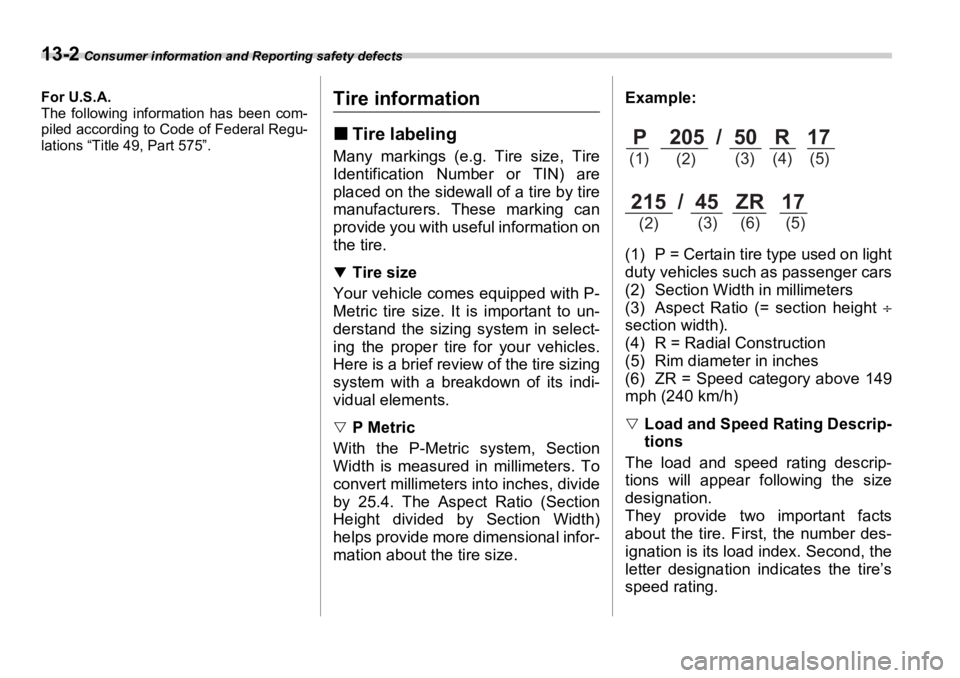
13-2 Consumer information and Reporting safety defects Consumer information and Reporting safety defects
For U.S.A.
The following information has been com-
piled according to Code of Federal Regu-
lations “Title 49, Part 575”.
Tire information �„ Tire labeling Many markings (e.g. Tire size, Tire
Identification Number or TIN) are
placed on the sidewall of a tire by tire
manufacturers. These marking can
provide you with useful information on
the tire. �T
Tire size
Your vehicle comes equipped with P-
Metric tire size. It is important to un-
derstand the sizing system in select-
ing the proper tire for your vehicles.
Here is a brief review of the tire sizing
system with a breakdown of its indi-
vidual elements.
�V
P Metric
With the P-Metric system, Section
Width is measured in millimeters. To
convert millimeters in to inches, divide
by 25.4. The Aspect Ratio (Section
Height divided by Section Width)
helps provide more dimensional infor-
mation about the tire size. Example:
(1) P = Certain tire type used on light
duty vehicles such as passenger cars
(2) Section Width in millimeters
(3) Aspect Ratio (= section height ÷
section width).
(4) R = Radial Construction
(5) Rim diameter in inches
(6) ZR = Speed category above 149
mph (240 km/h)
�V
Load and Speed Rating Descrip-
tions
The load and speed rating descrip-
tions will appear following the size
designation.
They provide two important facts
about the tire. First, the number des-
ignation is its load index. Second, the
letter designation indicates the tire’s
speed rating.P 205 / 50 R 17 (1)
(2) (3) (4) (5)
215 / 45 ZR 17 (2) (3) (6) (5)
Page 402 of 425
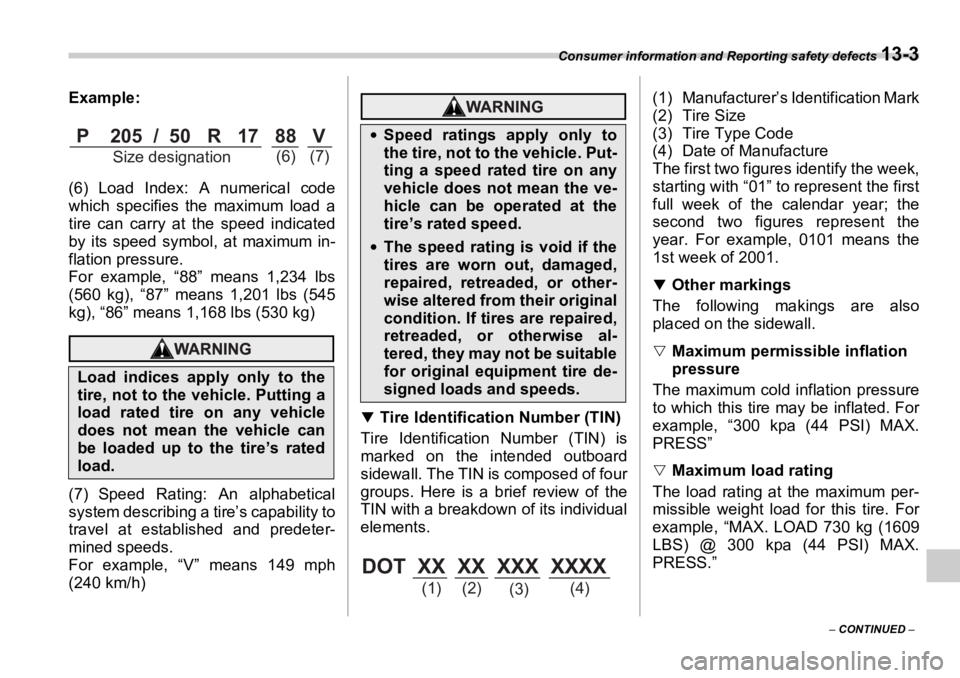
Consumer information and Reporting safety defects
13-3
– CONTINUED –Example:
(6) Load Index: A numerical code
which specifies the maximum load a
tire can carry at the speed indicated
by its speed symbol, at maximum in-
flation pressure.
For example, “88” means 1,234 lbs
(560 kg), “87” means 1,201 lbs (545
kg), “86” means 1,168 lbs (530 kg)
(7) Speed Rating: An alphabetical
system describing a tire’s capability to
travel at established and predeter-
mined speeds.
For example, “V” means 149 mph
(240 km/h) �T
Tire Identification Number (TIN)
Tire Identification Number (TIN) is
marked on the intended outboard
sidewall. The TIN is composed of four
groups. Here is a brief review of the
TIN with a breakdown of its individual
elements. (1) Manufacturer’s Identification Mark
(2) Tire Size
(3) Tire Type Code
(4) Date of Manufacture
The first two figures identify the week,
starting with “01” to represent the first
full week of the calendar year; the
second two figures represent the
year. For example, 0101 means the
1st week of 2001. �T
Other markings
The following makings are also
placed on the sidewall. �V
Maximum permissible inflation
pressure
The maximum cold inflation pressure
to which this tire may be inflated. For
example, “300 kpa (44 PSI) MAX.
PRESS”
�V
Maximum load rating
The load rating at the maximum per-
missible weight load for this tire. For
example, “MAX. LOAD 730 kg (1609
LBS) @ 300 kpa (44 PSI) MAX.
PRESS.”Load indices apply only to the
tire, not to the vehicle. Putting a
load rated tire on any vehicle
does not mean the vehicle can
be loaded up to the tire’s rated
load. P 205 / 50 R 17 88 V Size designation (6) (7) �y
Speed ratings apply only to
the tire, not to the vehicle. Put-
ting a speed rated tire on any
vehicle does not mean the ve-
hicle can be operated at the
tire’s rated speed. �y
The speed rating is void if the
tires are worn out, damaged,
repaired, retreaded, or other-
wise altered from their original
condition. If tires are repaired,
retreaded, or otherwise al-
tered, they may not be suitable
for original equipment tire de-
signed loads and speeds.
DOT XX XX XXX XXXX (1) (2)
(3) (4)
Page 403 of 425
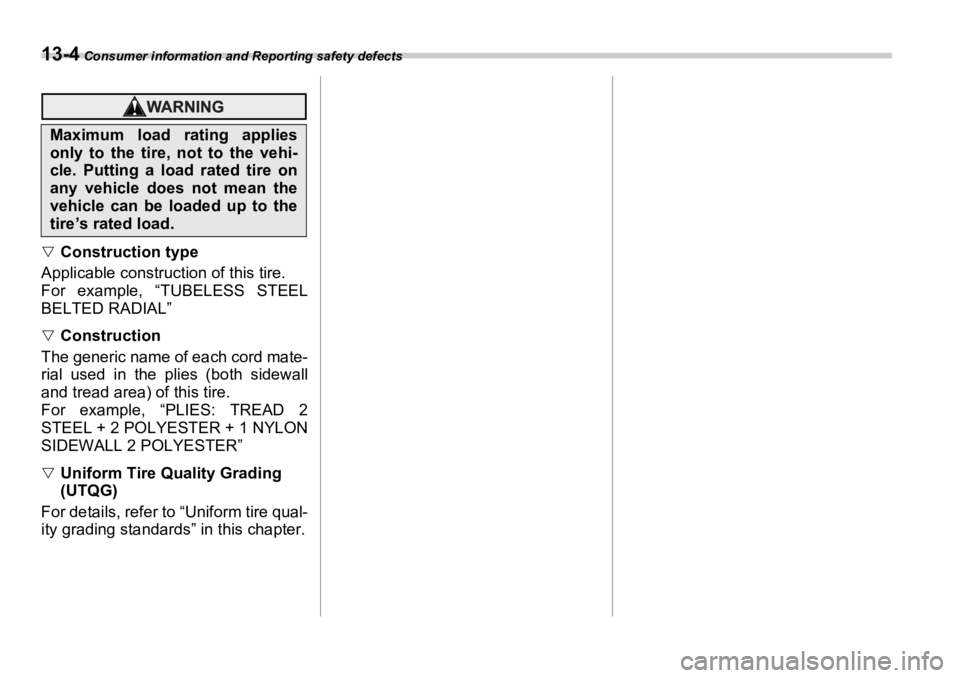
13-4 Consumer information and Reporting safety defects
�V
Construction type
Applicable construction of this tire.
For example, “TUBELESS STEEL
BELTED RADIAL” �V
Construction
The generic name of each cord mate-
rial used in the plies (both sidewall
and tread area) of this tire.
For example, “PLIES: TREAD 2
STEEL + 2 POLYESTER + 1 NYLON
SIDEWALL 2 POLYESTER”
�V
Uniform Tire Quality Grading
(UTQG)
For details, refer to “Uniform tire qual-
ity grading standards” in this chapter. Maximum load rating applies
only to the tire, not to the vehi-
cle. Putting a load rated tire on
any vehicle does not mean the
vehicle can be loaded up to the
tire’s rated load.
Page 404 of 425

Consumer information and Reporting safety defects
13-5
– CONTINUED –�„ Recommended tire inflation pressure�T
Recommended cold tire inflation pressure
Recommended cold tire inflation pressure for your vehicle’s tires is as follows,
Tire size P205/50R17 88V 215/45ZR17 P225/55R17 95V
Wheel size 17 × 7 JJ
Pressure Front 33 psi (230 kPa, 2.3 kgf/cm 2
) 35 psi (240 kPa, 2.4 kgf/cm 2
) 32 psi (220 kPa, 2.2 kgf/cm 2
)
Rear 32 psi (220 kPa, 2.2 kgf/cm 2
) 33 psi (230 kPa, 2.3 kgf/cm 2
) 30 psi (210 kPa, 2.1 kgf/cm 2
)
Rear at trailer
towing – 32 psi (220 kPa, 2.2 kgf/cm 2
)
Temporary
spare tire Size T135/80R16 T135/70D17 T155/70D17
Pressure 60 psi (420 kPa, 4.2 kgf/cm 2
)
Page 405 of 425
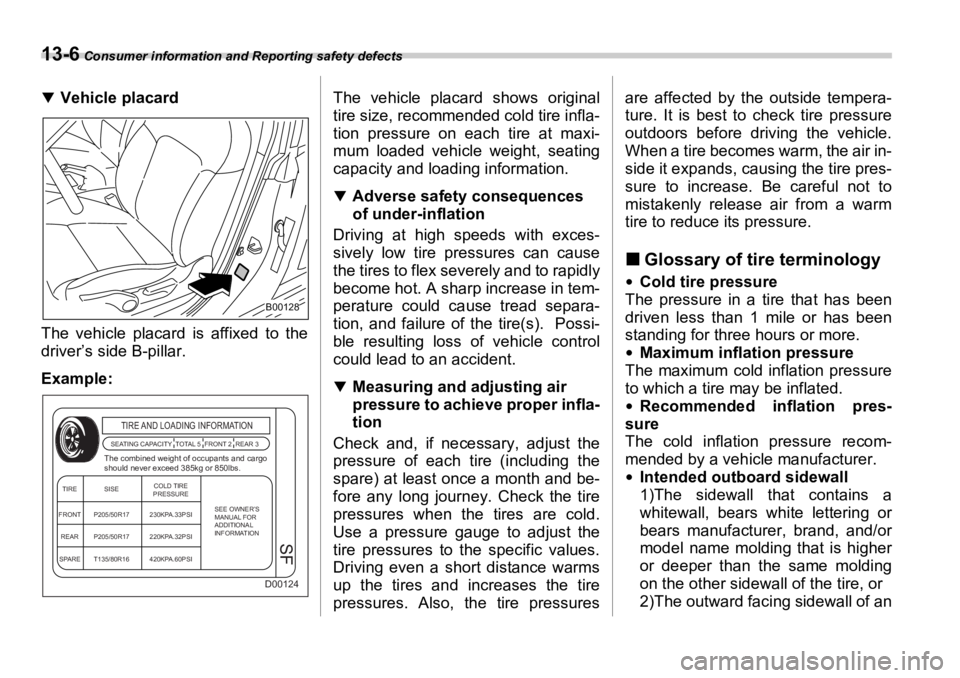
13-6 Consumer information and Reporting safety defects
�T
Vehicle placard
The vehicle placard is affixed to the
driver’s side B-pillar.
Example: The vehicle placard shows original
tire size, recommended cold tire infla-
tion pressure on each tire at maxi-
mum loaded vehicle weight, seating
capacity and loading information. �T
Adverse safety consequences
of under-inflation
Driving at high speeds with exces-
sively low tire pressures can cause
the tires to flex severely and to rapidly
become hot. A sharp increase in tem-
perature could cause tread separa-
tion, and failure of the tire(s). Possi-
ble resulting loss of vehicle control
could lead to an accident. �T
Measuring and adjusting air
pressure to achieve proper infla-
tion
Check and, if necessary, adjust the
pressure of each tire (including the
spare) at least once a month and be-
fore any long journey. Check the tire
pressures when th e tires are cold.
Use a pressure gauge to adjust the
tire pressures to the specific values.
Driving even a short distance warms
up the tires and increases the tire
pressures. Also, th e tire pressures are affected by the outside tempera-
ture. It is best to check tire pressure
outdoors before driving the vehicle.
When a tire becomes warm, the air in-
side it expands, causing the tire pres-
sure to increase. Be careful not to
mistakenly release air from a warm
tire to reduce its pressure.
�„ Glossary of tire terminology �y
Cold tire pressure
The pressure in a tire that has been
driven less than 1 mile or has been
standing for three hours or more. �y
Maximum inflation pressure
The maximum cold inflation pressure
to which a tire may be inflated. �y
Recommended inflation pres-
sure
The cold inflation pressure recom-
mended by a vehicle manufacturer. �y
Intended outboard sidewall
1)The sidewall that contains a
whitewall, bears white lettering or
bears manufacturer, brand, and/or
model name molding that is higher
or deeper than the same molding
on the other sidewall of the tire, or
2)The outward facing sidewall of anB00128
D00124TIRE AND LOADING INFORMATION SEATING CAPACITY TOTAL 5 FRONT 2 REAR 3
The combined weight of occupants and cargo
should never exceed 385kg or 850lbs.TIRE SISE
FRONT P205/50R17
P205/50R17
T135/80R16 230KPA.33PSI
220KPA.32PSI
420KPA.60PSIREAR
SPARE COLD TIRE
PRESSURE
SEE OWNER’S
MANUAL FOR
ADDITIONAL
INFORMATION
SF
Page 406 of 425

Consumer information and Reporting safety defects
13-7
– CONTINUED –asymmetrical tire that has a particu-
lar side that must always face out-
ward when mounting on a vehicle.�y
Accessory weight
The combined weight (in excess of
those standard items which may be
replaced) of floor mats, leather seats
and cross bars to the extent that these
items are available as factory-in-
stalled equipment (whether installed
or not). �y
Curb weight
The weight of a motor vehicle with
standard equipment including the
maximum capacity of fuel, oil, and
coolant and air conditioning. �y
Maximum loaded vehicle weight
The sum of curb weight, accessory
weight, vehicle capacity weight and
production options weight. �y
Normal occupant weight
150 lbs (68 kg) times the number of
occupants (3 occupants).
�y
Occupant distribution
Distribution of occupants in a vehicle,
2 in front, 1 in rear seat.
�y
Production options weight
The combined weight of those in-
stalled regular production options weighing over 5.1 lbs (2.3 kg) in ex-
cess of those standards items which
they replace, not previously consid-
ered in curb weight or accessory
weight. �y
Vehicle capacity weight
The total weight of cargo, luggage
and occupants that can be added to
the vehicle. �y
Vehicle maximum load on a tire
Load on an individual tire that is deter-
mined by distributing to each axle its
share of the maximum loaded vehicle
weight and dividing by two. �y
Vehicle normal load on a tire
Load on an individual tire that is deter-
mined by distributing to each axle its
share of the curb weight, accessory
weight, and normal occupant weight
and dividing by two.
�„ Tire care – maintenance and
safety practices �y
Check on a daily basis that the tires
are free from serious damage, nails,
and stones. At the same time, check
the tires for abnormal wear.
�y
Inspect the tire tread regularly and
replace the tires before their tread wear indicators become visible. When
a tire’s tread wear indicator becomes
visible, the tire is worn beyond the ac-
ceptable limit and must be replaced
immediately. With a tire in this condi-
tion, driving at even low speeds in wet
weather can cause the vehicle to hy-
droplane. Possible resulting loss of
vehicle control can lead to an acci-
dent. �y
To maximize the life of each tire and
ensure that the tires wear uniformly, it
is best to rotate the tires every 7,500
miles (12,500 km). Rotating the tires
involves switching the front and rear
tires on the right-hand side of the ve-
hicle and similarly switching the front
and rear tires on the left-hand side of
the vehicle. (Each tire must be kept on
its original side of the vehicle.) Re-
place any damaged or unevenly worn
tire at the time of ro tation. After tire ro-
tation, adjust the tire pressures and
make sure the wheel nuts are correct-
ly tightened. A tightening torque spec-
ification and a tightening sequence
specification for the wheel nuts can be
found “Flat tires” section in chapter 9.
Page 407 of 425
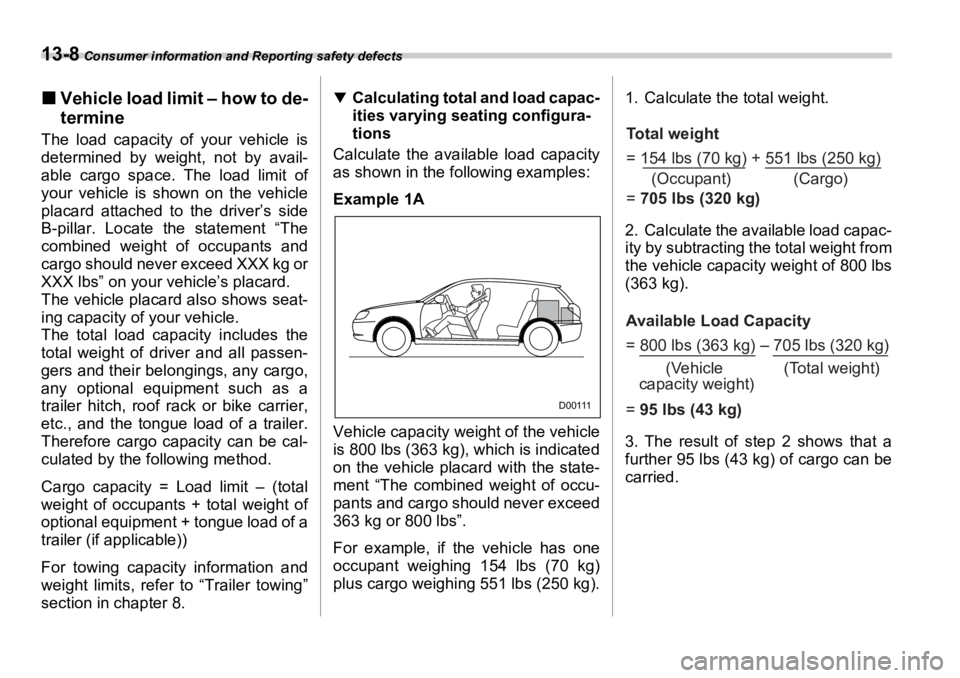
13-8 Consumer information and Reporting safety defects
�„ Vehicle load limit – how to de-
termineThe load capacity of your vehicle is
determined by weight, not by avail-
able cargo space. The load limit of
your vehicle is shown on the vehicle
placard attached to the driver’s side
B-pillar. Locate the statement “The
combined weight of occupants and
cargo should never exceed XXX kg or
XXX lbs” on your vehicle’s placard.
The vehicle placard also shows seat-
ing capacity of your vehicle.
The total load capacity includes the
total weight of driver and all passen-
gers and their belongings, any cargo,
any optional equipment such as a
trailer hitch, roof rack or bike carrier,
etc., and the tongue load of a trailer.
Therefore cargo capacity can be cal-
culated by the following method.
Cargo capacity = Load limit – (total
weight of occupant s + total weight of
optional equipment + tongue load of a
trailer (if applicable))
For towing capacity information and
weight limits, refe r to “Trailer towing”
section in chapter 8. �T
Calculating total and load capac-
ities varying seating configura-
tions
Calculate the available load capacity
as shown in the following examples:
Example 1A
Vehicle capacity weight of the vehicle
is 800 lbs (363 kg), which is indicated
on the vehicle placard with the state-
ment “The combined weight of occu-
pants and cargo should never exceed
363 kg or 800 lbs”.
For example, if the vehicle has one
occupant weighing 154 lbs (70 kg)
plus cargo weighing 551 lbs (250 kg). 1. Calculate the total weight.
2. Calculate the available load capac-
ity by subtracting the total weight from
the vehicle capacity weight of 800 lbs
(363 kg).
3. The result of step 2 shows that a
further 95 lbs (43 kg) of cargo can be
carried. D00111Total weight
= 154 lbs (70 kg) + 551 lbs (250 kg)
= 705 lbs (320 kg) (Occupant) (Cargo)
Available Load Capacity
= 800 lbs (363 kg) 705 lbs (320 kg)
= 95 lbs (43 kg) (Vehicle
capacity weight) (Total weight)
Page 408 of 425
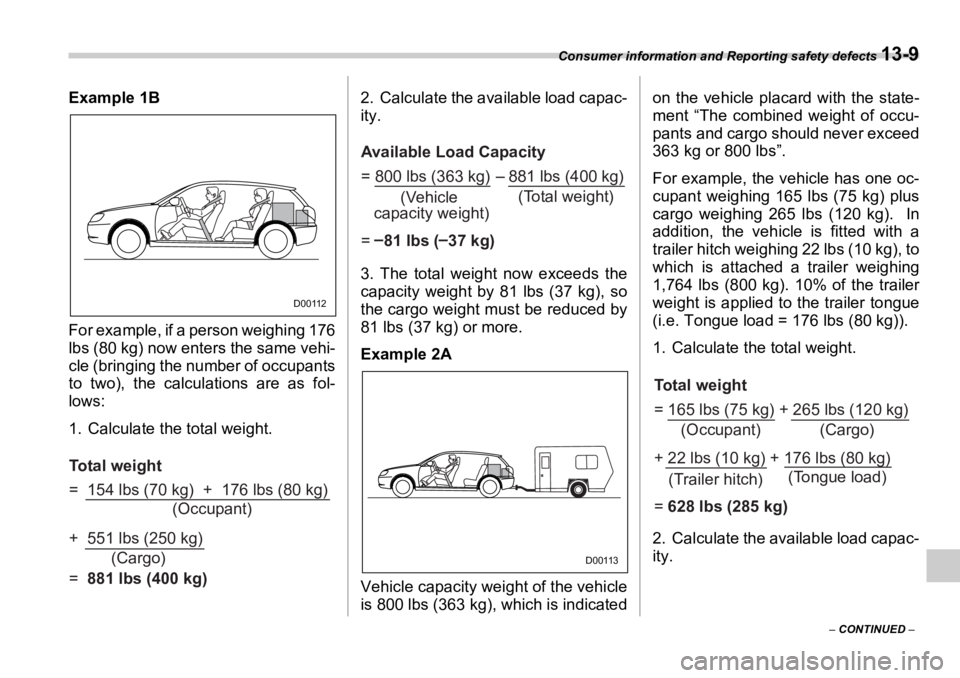
Consumer information and Reporting safety defects
13-9
– CONTINUED –Example 1B
For example, if a person weighing 176
lbs (80 kg) now enters the same vehi-
cle (bringing the number of occupants
to two), the calculations are as fol-
lows:
1. Calculate the total weight. 2. Calculate the ava ilable load capac-
ity.
3. The total weight now exceeds the
capacity weight by 81 lbs (37 kg), so
the cargo weight must be reduced by
81 lbs (37 kg) or more.
Example 2A
Vehicle capacity weight of the vehicle
is 800 lbs (363 kg), which is indicated on the vehicle plac ard with the state-
ment “The combined weight of occu-
pants and cargo should never exceed
363 kg or 800 lbs”.
For example, the vehicle has one oc-
cupant weighing 165 lbs (75 kg) plus
cargo weighing 265 lbs (120 kg). In
addition, the vehicle is fitted with a
trailer hitch weighing 22 lbs (10 kg), to
which is attached a trailer weighing
1,764 lbs (800 kg). 10% of the trailer
weight is applied to the trailer tongue
(i.e. Tongue load = 176 lbs (80 kg)).
1. Calculate the total weight.
2. Calculate the available load capac-
ity.D00112
Total weight
= 154 lbs (70 kg) + 176 lbs (80 kg)
+ 551 lbs (250 kg)
= 881 lbs (400 kg) (Occupant)
(Cargo) Available Load Capacity
= 800 lbs (363 kg) 881 lbs (400 kg)
= 81 lbs ( 37 kg) (Vehicle
capacity weight) (Total weight)
D00113Total weight
= 165 lbs (75 kg) + 265 lbs (120 kg)
+ 22 lbs (10 kg) + 176 lbs (80 kg)
= 628 lbs (285 kg) (Occupant) (Cargo)
(Trailer hitch) (Tongue load)
Page 409 of 425
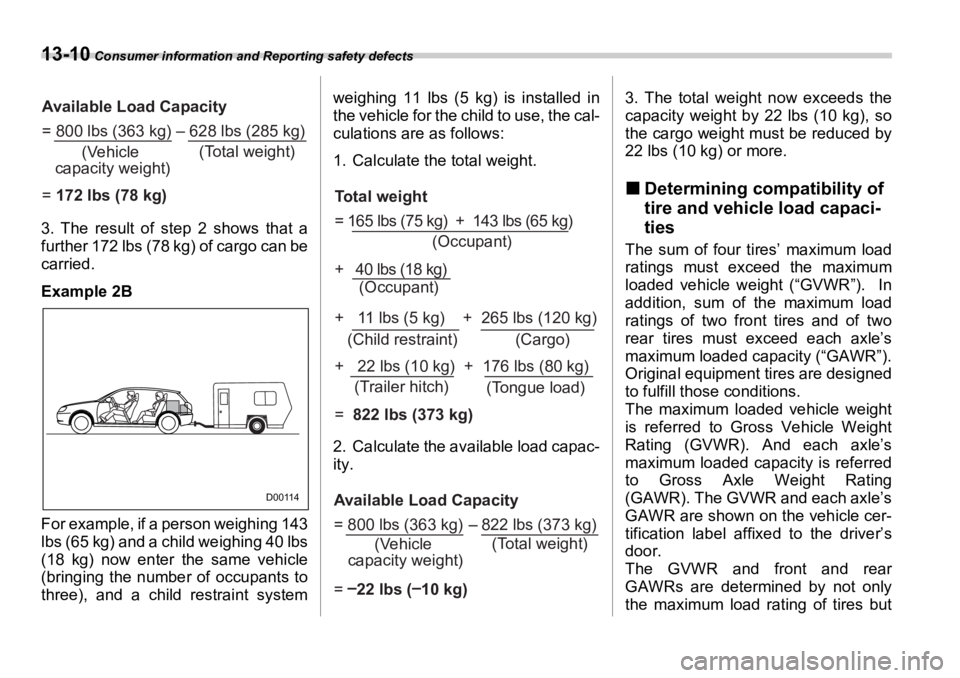
13-10 Consumer information and Reporting safety defects
3. The result of step 2 shows that a
further 172 lbs (78 kg) of cargo can be
carried.
Example 2B
For example, if a person weighing 143
lbs (65 kg) and a child weighing 40 lbs
(18 kg) now enter the same vehicle
(bringing the number of occupants to
three), and a child restraint system weighing 11 lbs (5 kg) is installed in
the vehicle for the child to use, the cal-
culations are as follows:
1. Calculate the total weight.
2. Calculate the available load capac-
ity. 3. The total weight now exceeds the
capacity weight by 22 lbs (10 kg), so
the cargo weight must be reduced by
22 lbs (10 kg) or more.
�„ Determining compatibility of
tire and vehicle load capaci-
ties The sum of four tires’ maximum load
ratings must exceed the maximum
loaded vehicle weight (“GVWR”). In
addition, sum of the maximum load
ratings of two front tires and of two
rear tires must exceed each axle’s
maximum loaded capacity (“GAWR”).
Original equipment tires are designed
to fulfill those conditions.
The maximum loaded vehicle weight
is referred to Gross Vehicle Weight
Rating (GVWR). And each axle’s
maximum loaded capacity is referred
to Gross Axle Weight Rating
(GAWR). The GVWR and each axle’s
GAWR are shown on the vehicle cer-
tification label affixed to the driver’s
door.
The GVWR and front and rear
GAWRs are determined by not only
the maximum load rating of tires butAvailable Load Capacity
= 800 lbs (363 kg) 628 lbs (285 kg)
= 172 lbs (78 kg) (Vehicle
capacity weight) (Total weight)
D00114Total weight
= 165 lbs (75 kg) + 143 lbs (65 kg)
+ 40 lbs (18 kg)
+ 11 lbs (5 kg) + 265 lbs (120 kg)
+ 22 lbs (10 kg) + 176 lbs (80 kg)
= 822 lbs (373 kg) (Occupant)
(Cargo)
(Trailer hitch)(Child restraint)
(Tongue load)(Occupant)
Available Load Capacity
= 800 lbs (363 kg) 822 lbs (373 kg)
= 22 lbs ( 10 kg) (Vehicle
capacity weight) (Total weight)
Page 410 of 425

Consumer information and Reporting safety defects
13-11also loaded capacities of the vehicle’s
suspension, axles and other parts of
the body.
Therefore, this means that the vehicle
cannot necessarily be loaded up to
the tire’s maximum load rating on the
tire sidewall.
�„ Adverse safety consequenc-
es of overloading on handling
and stopping and on tiresOverloading could affect vehicle han-
dling, stopping distance, vehicle and
tire as shown in the following. This
could lead to an accident and possibly
result in severe personal injury.�y
Vehicle stability will deteriorate.�y
Heavy and/or high-mounted loads
could increase the risk of rollover. �y
Stopping distance will increase.�y
Brakes could overheat and fail.�y
Suspension, bearings, axles and
other parts of the body could break or
experience accelerated wear that will
shorten vehicle life.
�y
Tires could fail.
�y
Tread separation could occur.
�y
Tire could separate from its rim. �„ Steps for Determining Cor-
rect Load Limit 1. Locate the statement “The com-
bined weight of occupants and cargo
should never exceed XXX pounds” on
your vehicle’s placard.
2. Determine the combined weight of
the driver and passengers that will be
riding in your vehicle.
3. Subtract the combined weight of
the driver and passengers from XXX
kilograms or XXX pounds.
4. The resulting figure equals the
available amount of cargo and lug-
gage load capacity. For example, if
the “XXX” amount equals 1,400 lbs
(635kg). and there will be five- 150 lbs
(68 kg) passengers in your vehicle,
the amount of available cargo and
luggage load capacity is 650 lbs.
(1,400 – 750 (5 × 150) = 650 lbs.)
5. Determine the combined weight of
luggage and cargo being loaded on
the vehicle. That weight may not safe-
ly exceed the available cargo and lug-
gage load capacity calculated in Step
4.
6. If your vehicle will be towing a trail-
er, load from your trailer will be trans- ferred to your vehicle. Consult this
manual to determine how this reduc-
es the available cargo and luggage
load capacity of your vehicle.